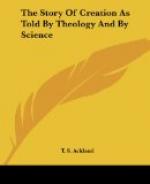The beginning of the fifth day may be assigned to a point near where the Trias is succeeded by the Lias. As the Trias is drawing to its close, the class of reptiles, whose first known appearance belongs to the carboniferous epoch of the third day, begins to show signs of advance. The first true Saurians are found in the Trias: the great development takes place in the Lias and Oolite, while in the chalk large quantities of kindred remains are found, which, however, are not identical with the species found in the earlier groups. Of these some were probably almost entirely aquatic, as their limbs take the form of paddles; others were purely terrestrial, a large proportion were amphibious, and some, as the pterodactylus, bore the same relation to the rest of their class as the bats bear to the other mammalia, being furnished with membranous wings, supported upon a special development of the anterior limbs. One important characteristic of the race at this time was the great size of many of its members: thirty feet is by no means an uncommon length. This marks the fitness of the name given to the class by Moses.
Very few actual remains of birds have been found; but this is not surprising, since birds would rarely be exposed to the conditions which were essential to the fossilization of their remains. The earliest known fossil bird is the Archaeopteryx, the remains of which were found in 1862 in the Solenhofen Slates, which belong to the Oolite formation. Though the actual remains of birds are very few, traces of their footprints have been found in many places, from the New Red Sandstone upwards, and these traces prove not only that they were very numerous, but also that they attained to a gigantic size, as their feet were sometimes from twelve to fifteen inches in length, and their stride extended from six to eight feet. During this period, then, these two classes must have been the dominant races of the earth. As the precursors of these classes made their appearance at a much earlier period, so the epoch of birds and reptiles witnessed the beginning and gradual advance of the class which was to succeed them in the foremost place—the mammalia. Generally, however, the mammalian remains of this period belong to what are considered the lower classes—the monotremata and marsupialia. The close of this period must have been a time of great disturbance in the Northern Hemisphere, since the chalk which runs through a great part of Northern Europe, and frequently attains a thickness of 1000 feet, must have been deposited at the bottom of a deep sea, and subsequently elevated.
Section 9. The sixth day.
1. The Mammalia.
“And God said, Let the earth cause to go forth the soul of life, cattle, and creeping thing, and the beast of the earth (wild animals) after his kind; and it was so.
“And God made the beast of the earth after his kind, and cattle after their kind, and every creeping thing of the ground after his kind; and God saw that it was good.”




